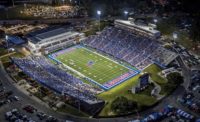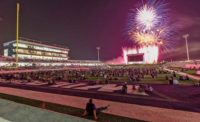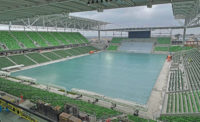San Antonio
Key Players
Owner San Antonio Independent School District
Lead Design Firm AECOM/RVK
General Contractor Joeris General Contractors Ltd./Hunt Construction
Structural Engineer Unintech Consulting Engineers
Civil/MEP Engineer AECOM
Turf Consultant Sports Design Group
San Antonio Independent School District’s Alamo Stadium, built in 1939 by the Works Progress Administration, is a nationally registered historic landmark. In November 2010, San Antonio voters approved a $515-million bond that included $35 million for renovation of the stadium and convocation center.
This project reworked the entire stadium, which required demolition, code-required upgrades and facility improvements. Special care went into restoration of the original wood bleachers and historic stadium features. Renovations to all existing limestone and all mechanical, electrical and plumbing systems proved challenging as the construction team discovered everything from a tunnel under the field to a city dump site on the property.
The historical designation of the facilities required extensive coordination with local and state authorities to ensure all design elements met approval and all materials met design specifications. Design called for preservation or duplication of many historical elements, including signature rock, the iconic entry and unique features placed by the original craftsmen, including a Madonna found within the walls.
Demolition crews were removing the existing field base when they discovered an underground drainage cistern. The cistern ran the entire length of the field and was deep enough to walk through at full height in some areas. Collaborating with the owner and engineers, it was determined the best course of action was to use the tunnel and pathways as part of the drainage system for the new field. Another issue was that the stadium allowed for one point of access for all equipment, requiring preplanning to avoid creating delays because of a blocked entry.
Excavation of the site surrounding the convocation center and stadium had to be precise, because while the stadium was built in an old rock quarry, a portion of the site had also been a city landfill at one point. Hundreds of old glass bottles were actually recovered as artifacts during the sitework process thanks to the care taken by the subcontractors.





Post a comment to this article
Report Abusive Comment